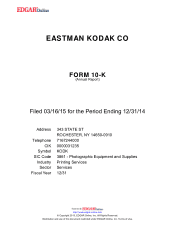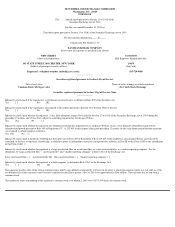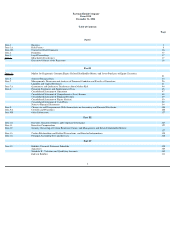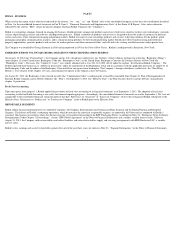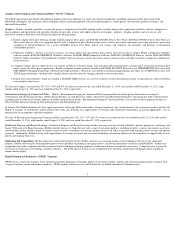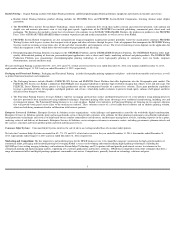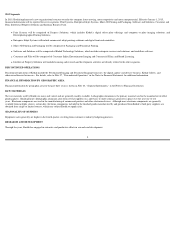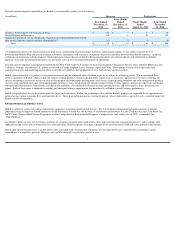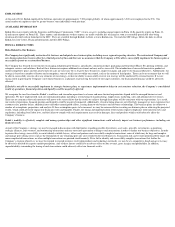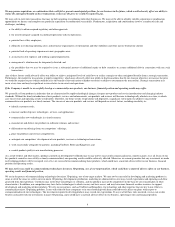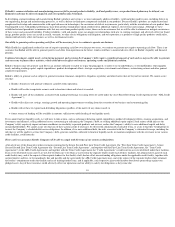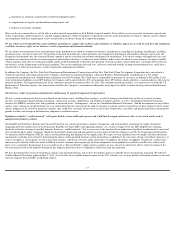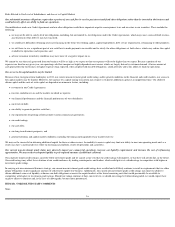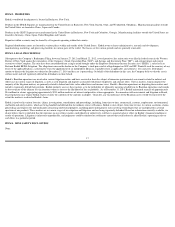Kodak 2014 Annual Report Download - page 8
Download and view the complete annual report
Please find page 8 of the 2014 Kodak annual report below. You can navigate through the pages in the report by either clicking on the pages listed below, or by using the keyword search tool below to find specific information within the annual report.
Research and development expenditures for Kodak’s two reportable segments were as follows:
(1)
Composed of interest cost, expected return on plan assets, amortization of actuarial gains and losses, amortization of prior service credits related to the U.S.
Postretirement Benefit Plan and special termination benefits, curtailments and settlement components of pension and other postretirement benefit expenses, except for
settlements in connection with the chapter 11 bankruptcy proceedings that are recorded in Reorganization items, net and curtailments and settlements included in
Earnings (loss) from discontinued operations, net of income taxes in the Consolidated Statement of Operations.
Research and development is headquartered in Rochester, New York. Other U.S. groups are located in Stamford, Connecticut; Dayton, Ohio; Oakdale, Minnesota; and
Columbus, Georgia. Outside the U.S., groups are located in Canada, England, Israel, Germany, Japan and China. These groups work in close cooperation with
manufacturing units and marketing organizations to develop new products and applications to serve both existing and new markets.
Kodak's general practice is to protect its investment in research and development and its freedom to use its inventions by obtaining patents. The ownership of these
patents contributes to Kodak's ability to provide industry-leading products. Kodak holds portfolios of patents in several areas important to its business, including the
specific technologies previously discussed, such as flexographic and lithographic printing plates and systems; digital printing workflow and color management proofing
systems; color and black-and-white electrophotographic printing systems; commercial and consumer inkjet writing systems, printers, and presses; inkjet inks and media;
functional printing materials, formulations, and deposition modalities; dye sublimation (thermal transfer) printing systems; and color negative films, processing and
papers. Each of these areas is important to existing and emerging business opportunities that bear directly on Kodak's overall business performance.
Kodak's major products are not dependent upon one single, material patent. Rather, the technologies that underlie Kodak's products are supported by an aggregation of
patents having various remaining lives and expiration dates. There is no individual patent, or group of patents, whose expiration is expected to have a material impact on
Kodak's results of operations.
ENVIRONMENTAL PROTECTION
Kodak is subject to various laws and governmental regulations concerning environmental matters. The U.S. federal environmental legislation and state regulatory
programs having an impact on Kodak include the Toxic Substances Control Act, the Resource Conservation and Recovery Act, the Clean Air Act, the Clean Water Act,
the NY State Chemical Bulk Storage Regulations and the Comprehensive Environmental Response, Compensation and Liability Act of 1980, as amended (the
“Superfund Law”).
It is Kodak’s policy to carry out its business activities in a manner consistent with sound health, safety and environmental management practices, and to comply with
applicable health, safety and environmental laws and regulations. Kodak continues to engage in programs for environmental, health and safety protection and control.
Based upon information presently available, future costs associated with environmental compliance are not expected to have a material effect on Kodak's capital
expenditures or competitive position, although costs could be material to a particular quarter or year.
(in millions)
Successor
Predecessor
Year Ended
December 31,
2014
Four Months
Ended
December 31,
2013
Eight Months
Ended
August 31, 2013
Year Ended
December
31, 2012
Graphics, Entertainment and Commercial Films
$
21
$
7
$
13
$
40
Digital Printing and Enterprise
88
33
55
132
Impact of exclusion of certain components of pension and other postretirement benefit
plan income from the segment measure of profitability
(1)
(15
)
(7
)
(2
)
(4
)
Total
$
94
$
33
$
66
$
168
7

